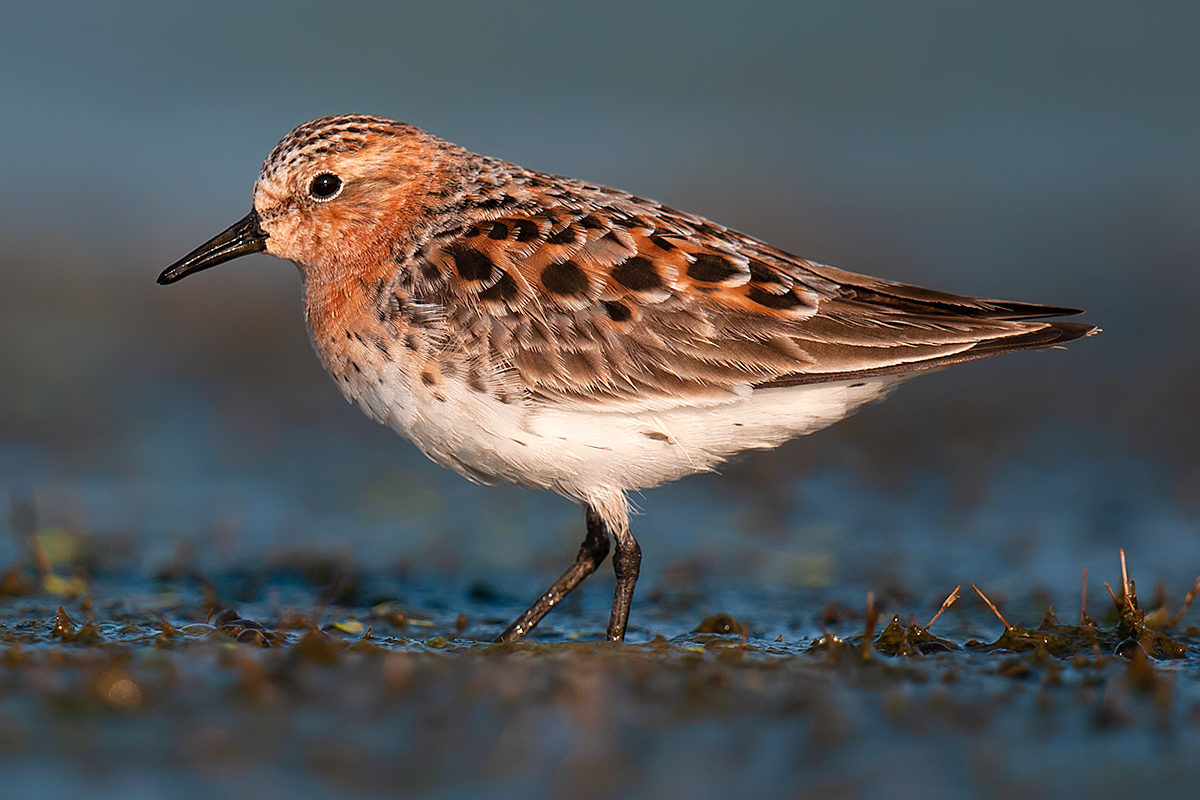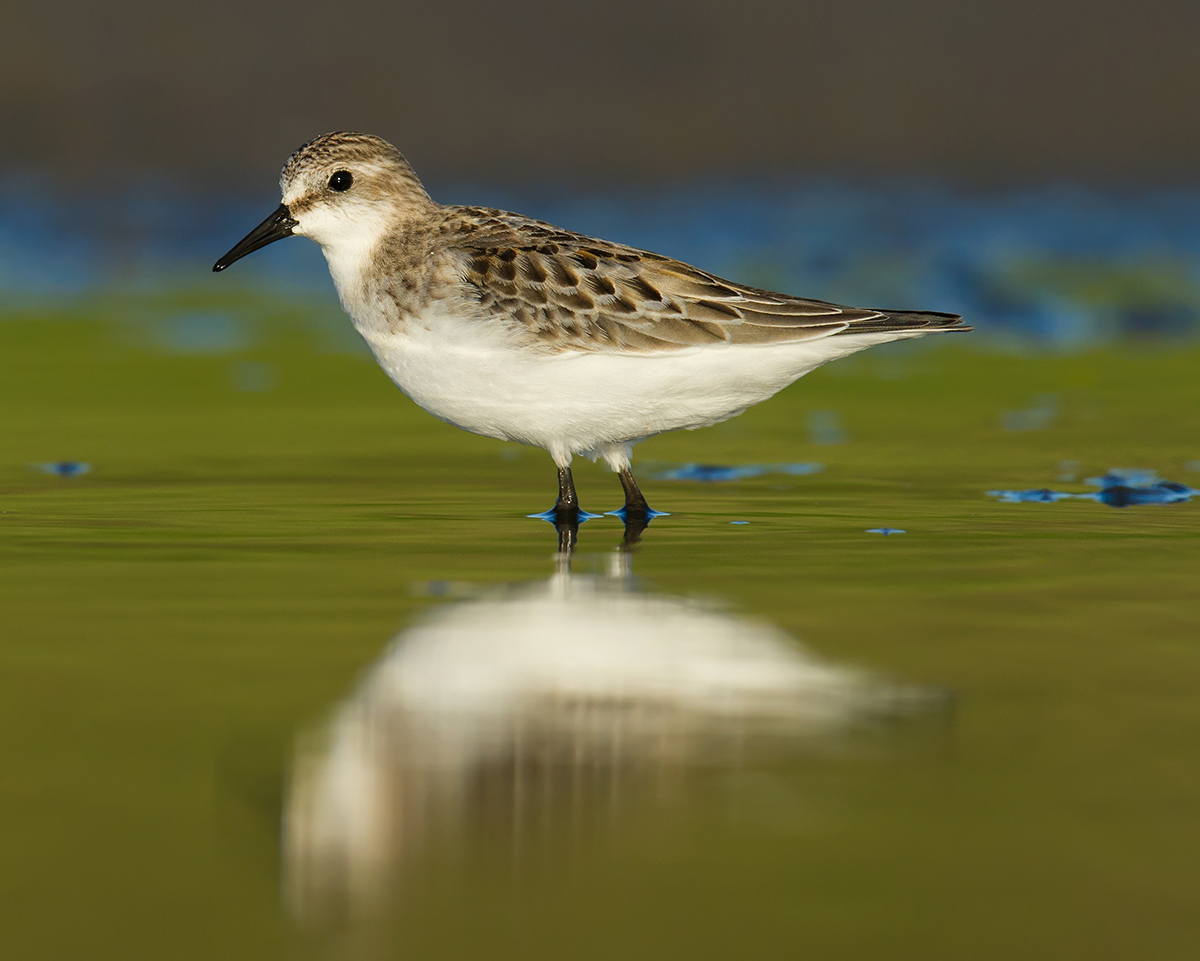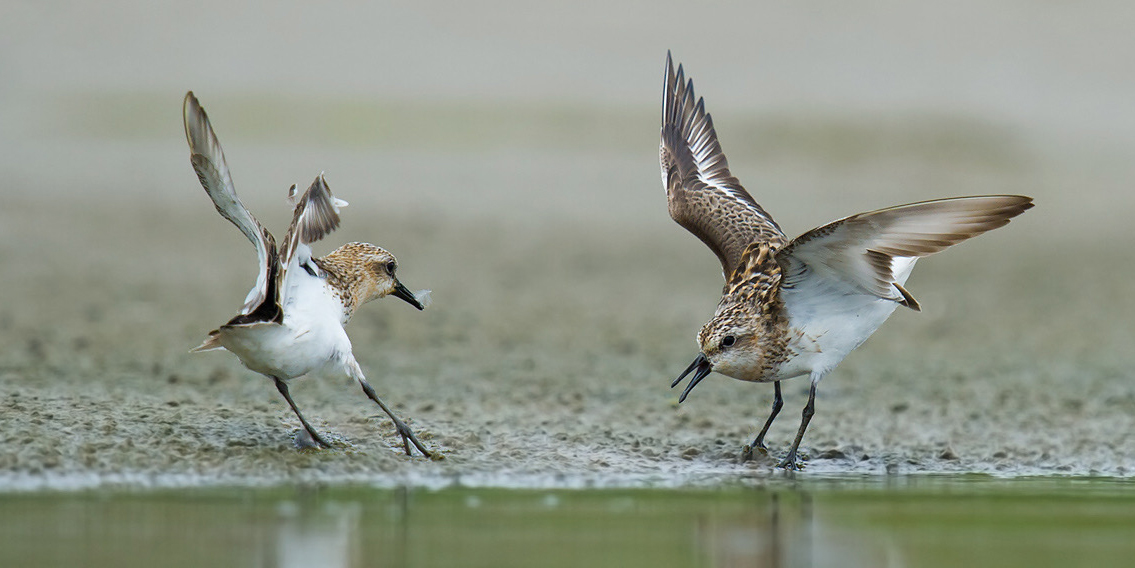
by Craig Brelsford
Founder, shanghaibirding.com
Red-necked Stint Calidris ruficollis is one of the more common shorebirds migrating along the Chinese coast. Some overwinter on southeast coast as far north as Shanghai. Regularly reported inland. HABITAT & BEHAVIOR Migrants on mudflats and around coastal lagoons and marshes. Often in flocks, sometimes large, often mixed, walking briskly and pecking constantly. ID & COMPARISON Once considered conspecific with Little Stint C. minuta. Summer mostly rufous-orange on head, neck, throat, and upper breast. (Throat of Little Stint always white.) Fairly dense streaking on crown, light streaking on back of neck and ear coverts, rest of rufous area largely unstreaked (unlike Little). Forehead and chin white. Arrowheads cover top of upper breast below rufous hood; in Little, small arrowheads are always contained within the wash on upper breast. Sometimes arrowheads form necklace around upper breast; in Little markings more often confined to sides. Mantle and scapulars largely black with rufous and white fringes and tips; “V” of mantle usually absent, conspicuous in Little. Tertials and wing coverts mainly grey, contrasting with rufous mantle and scapulars; no obvious contrast in Little, as wing coverts and tertials also fringed rufous. Underparts below necklace white. Breeding Sanderling C. alba is a third larger than Red-necked, has shorter wings and longer and thicker bill, is red-brown on throat mottled with black, and lacks hind toe. Non-breeding more uniformly grey above than Little, which is usually a shade browner and has larger dark feather centers. Underparts white with grey on breast sides; usually well defined in Red-necked, sometimes extended as a complete breast band of diffuse speckles in Little. Little usually shows more streaking in grey on head and breast (but lighter than in summer); both have obvious white supercilium. Juveniles largely lack rufous coloring and have buffish breast-sides with diffuse speckling. Juvenile Little has rufous and white fringes to all of mantle, scapulars and wings. Non-breeding Western Sandpiper C. mauri has longer legs and more distinct, fine streaking on breast sides; breeding Western bright rufous on scapulars and ear-coverts and has rufous wash to crown (but not on breast) and chevron-shaped black markings on breast and flanks. In flight, shows typical calidrid pattern of narrow white wing bar and white uppertail coverts divided by black central band from rump to tail. BARE PARTS Feet short, black, unwebbed; Long-toed Stint C. subminuta and Temminck’s Stint C. temminckii have yellowish legs; Western Sandpiper has partly webbed toes. Bill blunt, black. Red-necked Stint has shorter legs, blunter bill, and more elongated body than Little Stint. VOICE Kreep or kreek call, longer, deeper, and more trilling than Little Stint, somewhat reminiscent of Curlew Sandpiper C. ferruginea. — Craig Brelsford
PHOTOS


THE CALIDRIDS OF CHINA
shanghaibirding.com covers every species in the genus Calidris in China. Click any link:
Great Knot Calidris tenuirostris
Red Knot C. canutus
Ruff C. pugnax
Broad-billed Sandpiper C. falcinellus
Sharp-tailed Sandpiper C. acuminata
Curlew Sandpiper C. ferruginea
Temminck’s Stint C. temminckii
Long-toed Stint C. subminuta
Spoon-billed Sandpiper C. pygmaea
Red-necked Stint C. ruficollis
Sanderling C. alba
Dunlin C. alpina
Rock Sandpiper C. ptilocnemis
Baird’s Sandpiper C. bairdii
Little Stint C. minuta
Least Sandpiper C. minutilla
White-rumped Sandpiper C. fuscicollis
Buff-breasted Sandpiper C. subruficollis
Pectoral Sandpiper C. melanotos
Western Sandpiper C. mauri
REFERENCES
Alderfer, Jonathan, ed. (2006). National Geographic Complete Birds of North America. National Geographic Society, Washington, D.C.
Brazil, Mark (2009). Birds of East Asia. Princeton University Press, New Jersey.
Brazil, Mark (2018). Birds of Japan. Helm Field Guides, London.
eBird (2020). eBird: An online database of bird distribution and abundance [web application]. eBird, Cornell Lab of Ornithology, Ithaca, New York. Red-necked Stint (https://ebird.org/species/rensti). Accessed: 29 May 2020.
MacKinnon, John & Karen Phillipps (2000). A Field Guide to the Birds of China. Oxford University Press.
Message, Stephen & Don Taylor (2005). Waders of Europe, Asia and North America. Helm Field Guides, London.
Svensson, Lars, Killian Mullarney, & Dan Zetterström (2009). Collins Bird Guide: The Most Complete Guide to the Birds of Britain and Europe. 2nd ed. HarperCollins, London.
ACKNOWLEDGEMENTS
Daniel Bengtsson served as chief ornithological consultant for Craig Brelsford’s Photographic Field Guide to the Birds of China, from which this species description is drawn.
